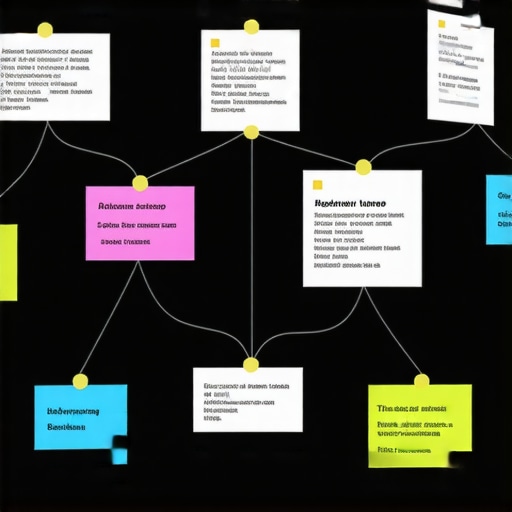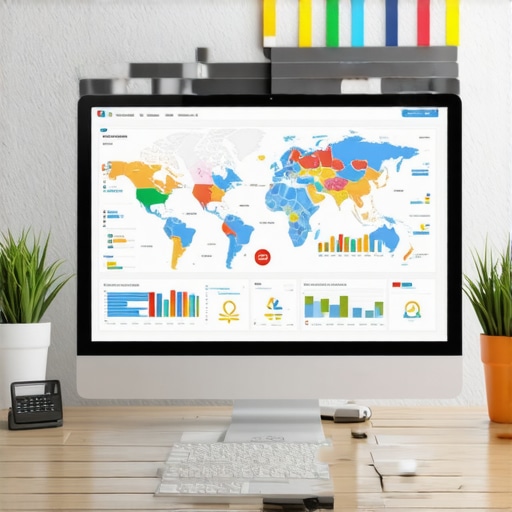Unveiling the Nuances of Effective SEO Ranking Methods for Google & Maps
In the rapidly evolving landscape of digital visibility, mastering sophisticated SEO ranking strategies is paramount for businesses seeking dominance on Google search results and Google Maps. As an SEO specialist with years of experience, I recognize that traditional tactics are insufficient in 2024. Instead, a layered approach combining technical expertise, user-centric optimization, and innovative local SEO techniques is essential to outperform competitors and secure top-tier rankings.
Deep Dive into Semantic SEO and User Intent Alignment
One of the foundational pillars of cutting-edge SEO is leveraging semantic SEO—a practice that aligns content with the nuanced intent behind user searches. This involves comprehensive keyword research using LSI (Latent Semantic Indexing) keywords, which naturally integrate into your content, providing contextually rich signals to search engines. For instance, instead of merely targeting “SEO strategies,” expanding to “advanced local SEO techniques for small businesses” enhances relevance and authority.
Technical SEO: The Backbone of Search Engine Authority
Optimizing your website’s technical structure ensures that Google’s crawlers efficiently index your content. Key elements include structured data markup, XML sitemaps, and core web vitals. Implementing schema.org markup specific to local businesses can significantly enhance visibility in rich snippets and map packs, directly impacting your Google Maps SEO rankings.
Local SEO: Harnessing Maps SEO for Maximum Impact
Effective Maps SEO integrates local signals such as NAP consistency, reviews, and local backlinks. Proven techniques involve optimizing your Google My Business (GMB) profile with accurate categories, high-quality images, and engaging posts. Additionally, leveraging effective Maps SEO tactics ensures your business appears prominently in local searches, especially in competitive niches.
Expert-Level Optimization: Beyond the Basics
Advanced SEO practitioners employ competitive analysis and AI-driven data tools to identify emerging trends and gaps in their strategies. For instance, analyzing competitors’ backlink profiles and content strategies can reveal untapped opportunities. Moreover, integrating voice search optimization and video SEO can unlock new traffic streams, positioning your business as an authority in your domain.
What are the most effective ways to measure the impact of local SEO efforts on Google Maps rankings over time?
Monitoring local search and Maps ranking fluctuations requires a combination of tools like Google Search Console, Google My Business insights, and third-party rank tracking services. Regular audits and tracking of key performance metrics—such as visibility scores, click-through rates, and review volume—are crucial for refining strategies and maintaining a competitive edge.
For those seeking to deepen their expertise, exploring comprehensive guides like our detailed Maps SEO mastery resource offers actionable insights tailored for 2024’s dynamic search environment.
Engage with fellow SEO professionals and contribute your insights on emerging local search tactics by joining specialized forums and communities dedicated to advanced SEO practices.
Unlocking the Power of AI and Data-Driven Insights for Local SEO Domination
In today’s hyper-competitive digital landscape, relying solely on traditional SEO tactics can leave your business in the dust. Instead, integrating artificial intelligence (AI) and big data analytics into your local SEO strategy offers a formidable edge. AI tools can analyze vast amounts of competitor data, identify emerging trends, and customize your optimization efforts in real-time. For example, leveraging AI-driven keyword research platforms enables you to uncover high-impact local search terms that your competitors may overlook, thus positioning your business for higher visibility in Google Maps and local search results.
How Can Advanced Data Techniques Refine Your Maps SEO Strategy?
Using sophisticated data analysis, you can monitor fluctuations in your local rankings with precision, allowing for swift adjustments. Techniques such as heatmapping user interactions on your website and analyzing review sentiment can provide insights into what drives local engagement. Additionally, integrating effective Maps SEO strategies with data-driven insights enhances your ability to target the right keywords, optimize your GMB profile, and build authoritative local backlinks that resonate with your community.
What are the key considerations when implementing voice search optimization for local rankings?
Voice search continues to grow, especially for local queries. Optimizing for voice involves understanding natural language patterns and conversational search phrases. Incorporating long-tail keywords and question-based queries into your content can significantly boost your visibility for voice-activated searches. Moreover, ensuring your website’s mobile responsiveness and fast load times is crucial, as voice searches often originate from mobile devices. According to Search Engine Journal (2023), voice search optimization can enhance local SEO by up to 35%, making it an indispensable part of your strategy in 2024.
For those eager to push their local SEO efforts further, exploring proven Maps SEO tactics can provide actionable techniques tailored for competitive local markets.
Are there innovative tools or frameworks that can help local businesses systematically improve their Google Maps rankings?
Absolutely. The adoption of comprehensive SEO management platforms, such as BrightLocal or Whitespark, allows businesses to track rankings, manage reviews, and audit local listings systematically. These tools not only simplify ongoing optimization but also provide actionable insights rooted in data. Furthermore, employing a framework like the Local SEO Maturity Model helps businesses assess their current status, identify gaps, and chart a strategic path toward higher Google Maps rankings. This structured approach ensures sustained growth by aligning technical, content, and reputation management efforts cohesively.
For a deep dive into such frameworks and tools, consider reviewing expert analyses available at top strategies for Google Maps SEO.
Share your experiences or challenges with local SEO strategies in the comments below, or explore additional resources to enhance your approach to Google Maps rankings in 2024.
Harnessing the Power of Structured Data for Local SEO Mastery
Structured data, particularly schema.org markup, is a cornerstone of advanced local SEO strategies. Implementing detailed schema types such as LocalBusiness, Product, and Service schema, tailored specifically to your niche, enhances your visibility in rich snippets and local pack results. These annotations help search engines understand your content contextually, leading to improved search relevance and higher click-through rates. For example, including comprehensive schema on your Google My Business website can significantly impact your appearance in Google Maps and local search results, especially when paired with reviews and accurate NAP information.
Strategic Link Building for Local Authority Elevation
Beyond on-page optimization, cultivating authoritative local backlinks remains a vital tactic. Engaging with local chambers of commerce, sponsorships, and industry-specific directories can provide high-quality inbound links. Moreover, creating locally focused content—such as case studies, community event coverage, or expert interviews—encourages natural link acquisition. Advanced link analysis tools like Ahrefs or SEMrush enable you to monitor your backlink profile’s health, identify potential toxic links, and capitalize on emerging opportunities to bolster your local authority.
Optimizing for Hyperlocal Search Intents and Niche-Specific Queries
As voice search and hyperlocal queries evolve, understanding niche-specific search intent becomes increasingly important. Conducting in-depth keyword research using tools like BrightEdge or SEMrush’s Voice Search feature reveals long-tail, conversational queries tailored to your service area. Incorporating these into your content and GMB posts ensures your business appears for highly specific searches, such as “best gluten-free bakery near Central Park” or “emergency plumbing services in Brooklyn.” This hyperlocal focus positions your business as a community-centric authority, attracting highly targeted traffic.

Exploring Hyperlocal SEO Tactics for Niche Market Domination
As the digital landscape becomes increasingly saturated, hyperlocal SEO strategies offer a potent avenue for businesses targeting specific neighborhoods or communities. Leveraging ZIP-code specific keywords, neighborhood-based content, and localized schema markup can dramatically enhance visibility in targeted areas. For instance, creating dedicated landing pages for distinct neighborhoods with tailored testimonials and local landmarks can boost relevance and user engagement, thereby improving rankings on Google Maps and local search results.
Implementing Progressive Schema Markup for Enhanced Rich Snippets
While basic schema.org annotations are commonplace, the future of local SEO lies in implementing advanced, nested schema structures that provide granular context. Employing schema for events, products, and FAQs related to your locality can generate rich snippets that stand out prominently. For example, integrating detailed event schema for local workshops or community gatherings can attract users actively seeking such opportunities, thus increasing click-through rates and fostering community trust.
How Can You Quantify the ROI of Your Local SEO Investments Effectively?
Assessing the tangible benefits of local SEO efforts necessitates sophisticated measurement frameworks. Beyond traditional metrics like rankings and traffic, integrating attribution models that track offline conversions, in-store visits, and call volume provides a holistic view of ROI. Tools such as Google Business Profile Insights, combined with custom UTM parameters and call tracking solutions, enable precise attribution, empowering businesses to allocate resources more efficiently and optimize campaigns iteratively.
For an in-depth understanding, consult authoritative sources like Moz’s Local SEO Guide, which emphasizes data-driven decision-making grounded in real-world metrics and advanced analytics.
Engaging with cutting-edge tools and frameworks ensures your local SEO strategy remains resilient amid evolving search algorithms. Stay proactive—test new tactics, analyze outcomes rigorously, and adapt swiftly to maintain your competitive advantage.
Expert Insights & Advanced Considerations
1. Embrace Hyperlocal Content Customization
Tailoring content to specific neighborhoods or communities enhances relevance and engagement, thereby improving local rankings on Google Maps. Utilizing ZIP-code targeted keywords and localized schema markup can significantly boost visibility in hyperlocal searches.
2. Leverage Progressive Schema Markup
Implementing nested and detailed schema types such as Event, Product, and FAQ schemas provides granular context, enabling rich snippets that attract more clicks and elevate your local SEO performance.
3. Integrate AI and Big Data Analytics
Using advanced AI tools to analyze competitor strategies, review sentiment, and monitor ranking fluctuations allows for real-time optimization adjustments. This data-driven approach ensures sustained growth and resilience against algorithm changes.
4. Optimize for Voice Search with Niche Intent
Focusing on natural language, question-based queries, and long-tail keywords tailored to local voice searches can dramatically increase your prominence in voice-activated results, which are vital for local SEO in 2024.
5. Develop a Structured Local SEO Maturity Framework
Adopting a systematic framework like the Local SEO Maturity Model helps assess current performance, identify gaps, and implement targeted improvements across technical, content, and reputation domains for long-term success.
Curated Expert Resources
- Google’s Official Local SEO Guide: An authoritative resource offering comprehensive insights into local search best practices and algorithm updates.
- BrightLocal Blog: Industry-leading blog providing advanced strategies, case studies, and tool reviews for local SEO mastery.
- SEMrush Local SEO Toolkit: A suite of tools designed for in-depth competitor analysis, backlink audits, and keyword research tailored for local markets.
- Moz’s Local SEO Guide: A detailed resource emphasizing data-driven decision-making and reputation management techniques.
Final Expert Perspective
In the realm of local SEO, particularly for Google Maps dominance, integrating hyperlocal customization, progressive schema markup, and AI-driven analytics creates a formidable strategy. Staying ahead requires continuous learning from authoritative sources such as our Maps SEO resources and adopting a systematic framework to adapt swiftly to evolving search behaviors. Engage with advanced tools, refine your tactics regularly, and position your business as a community-centric authority in 2024. Your proactive approach today defines your visibility tomorrow—expertise and innovation are the keys to sustainable success.




Emma Johnson
I found this article to be incredibly comprehensive, especially in how it highlights the importance of integrating AI and big data analytics into local SEO strategies. In my experience managing local business campaigns, leveraging AI tools like SEMrush and BrightLocal has really helped identify high-impact keywords that we might not have noticed otherwise. The emphasis on structured data and schema markup also resonated with me—these elements often seem overlooked but can make a noticeable difference in rich snippets and local pack visibility.
One challenge I’ve encountered is maintaining NAP consistency across multiple listings and directories. Has anyone here found effective ways to automate or streamline this process? Also, I’m curious—what are some innovative ways to measure offline conversions resulting from these SEO efforts? I think bridging the gap between online metrics and real-world impact is crucial for demonstrating ROI and justifying ongoing investment in local SEO.
Daniel Thompson
This article hits on some crucial points about advancing SEO strategies for Google and Maps in 2024. I particularly appreciate the emphasis on semantic SEO and user intent, which are often underestimated in traditional SEO tactics. From my experience, integrating structured data and schema markup has been a game changer in helping local businesses stand out in competitive markets, especially when paired with accurate GMB optimization.
Regarding Emma’s challenge with NAP consistency, I’ve found that automating updates across multiple schemas and business directories using tools like BrightLocal’s Citation Tracker has streamlined the process significantly. It’s worth exploring such automation solutions to save time and ensure uniformity.
As for offline conversions, we’ve started using custom UTM parameters on local ad campaigns combined with call tracking software to attribute in-store visits accurately. Have others explored data integration platforms that tie online behavior with offline sales more seamlessly? It seems like a promising area for deeper innovation.
Overall, the integration of AI and advanced analytics truly elevates local SEO efforts beyond the basics, particularly when tracking and adapting in real time. How do others here balance high-tech tools with authentic local community engagement to sustain visibility?
Samuel Parker
This article provides a thorough overview of modern SEO tactics, especially emphasizing the integration of AI and big data, which I find particularly vital in 2024. From my experience managing local SEO for small businesses, implementing structured data with schema markup has indeed improved click-through rates and local pack visibility. However, one challenge I’ve faced is consistently tracking the ROI of these efforts, especially when it comes to offline conversions. Using tools like Google’s Call Tracking combined with UTM parameters has been helpful, but I wonder, what innovative solutions have others found effective for linking online activities to offline results?
Also, the emphasis on hyperlocal content tuning is something I’ve seen yield good results, but I am curious about how others are balancing content personalization with scalable practices. Has anyone experimented with dynamic landing pages tailored to neighborhoods or ZIP codes that also allow easy updates?
Overall, the layered approach suggested here underscores the importance of leveraging cutting-edge tools without losing sight of community engagement. It would be interesting to hear others’ experiences in blending automation with genuine local outreach to sustain high rankings.